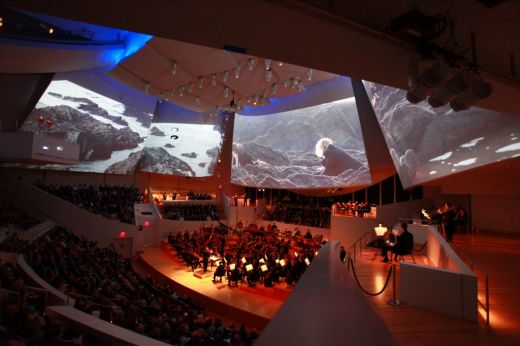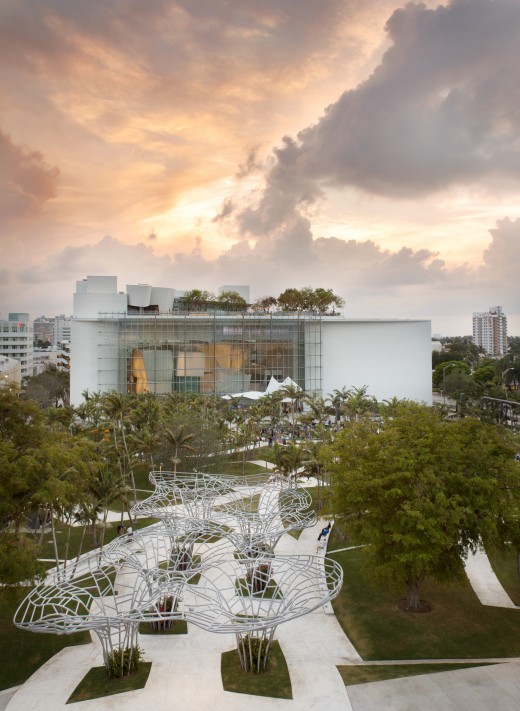The 5% Magic of Psychoacoustics
Jill Spalding

New World Symphony's world premiere of Polaris at New World Center. Photo by Rui Dias Aidos.
Full disclosure number two: after I bought my Miami Beach pad some ten years ago, I became instantly proprietary about several things: a sprawling ficus on the golf course off 29th and Pine that the artist Michele Oka Doner had shown me, a thrift store in Hialeah, and—most convenient for a quick run to the Lincoln Road flea market or a latte at the Van Dyke Café—the two parking lots (metered in nickels and dimes at the time) on 17th street. You see where I’m going; when the New World Center was announced, two big priorities collided. Delight that my guy had designed it met despair that the hall would swallow my favorite parking spot.
As with the planning board, culture trumped. The vision of a Frank Gehry imprimatur building rose before me: billowing sails, a reflective skin and a malleable structure that integrated the garden! Fixed on the formula that had marked him since Bilbao, I did not find the hard hat stage reassuring; a shrinking economy had stripped Gehry of the garden design, and the only signature flourish in the rigorously rectangular shell was a canopy.

New World Center and Miami Beach SoundScape. Photo by Emilio Collavino.
further considerations, shared by new music halls everywhere. Firstly, the need, dictated by a graying audience, to pull in the young, who want to dress casually, pay less, and socialize. (Witness the explosion of music cafes where people can mingle and tap into music at will.) Then, as ever, the budget—the bottom-line exigency that has been replacing labor, wherever unions allow, with low-cost technology capable of reconfiguring both stage and setting at the push of a button. Thirdly, the current demand for transparency that exacts a minimal disjunction between inside and outside. Lastly, the burgeoning imperative for an interactive experience made possible by technological innovations in digital imaging. New World Center has them all.
But what of the acoustics—still hopefully the primary concern? At the second opening night I found myself seated next to Yasuhisa Toyota, the renowned acoustician who had given Gehry’s Walt Disney Concert Hall a sound experience that was 95 percent perfection, universally held as an enormous achievement. Toyota has pulled off the same coup for the NWC, whose every element—shape, size, materials, slatted surrounds, seating, railings, flooring, and curved panels—has been addressed to create a technically near-perfect sound experience. What then of that elusive 5 percent?
It turns out that although computers and new technology can reconfigure and adapt materials previously antithetical to acoustics, such as metal and glass, without affecting the sound, there is still the x factor of clothing, empty seats, and even human bodies, which can compromise total achievement of the ideal Gehry calls the “magic straight out of Alice in Wonderland.”
I asked Toyota if anything could be done to capture this magic, and that’s when I learned about psychoacoustics. A great deal of what we hear is perception. If the surroundings are agreeable—safe, airy parking; easy access to food, drink, stage, and amenities; flattering lighting, social connectivity, and the reassurance of a full hall (the ideal number of seats is 600) that gives heightened value to your ticket and energizes the orchestra—then you will perceive the acoustics to be perfect.
Hence the inordinate measures taken by the NWC to convey a sense of excitement and well-being. No seat is farther than 13 rows from the stage, and the rows curve around to provide social interface. In front of your eyes, the click of a button resets 14 performing areas so that the space and sound needs of a trio can cede in a second to those of a full-scale orchestra, a ten-drum ensemble, or a solo recitation. Video that serves the music, rather than the other way round as in a movie score, plays off of undulating indoor panels and luminescent, large-scale digital Wallcasts that reach out to envelope the fans who have befriended the lawn as an extension of the hall. A comet streak of a bar brings the luminescence indoors, and yes, there is a party space: a luxuriant rooftop garden designed by the master of tropical, Raymond Jungles. Perception accomplished.










